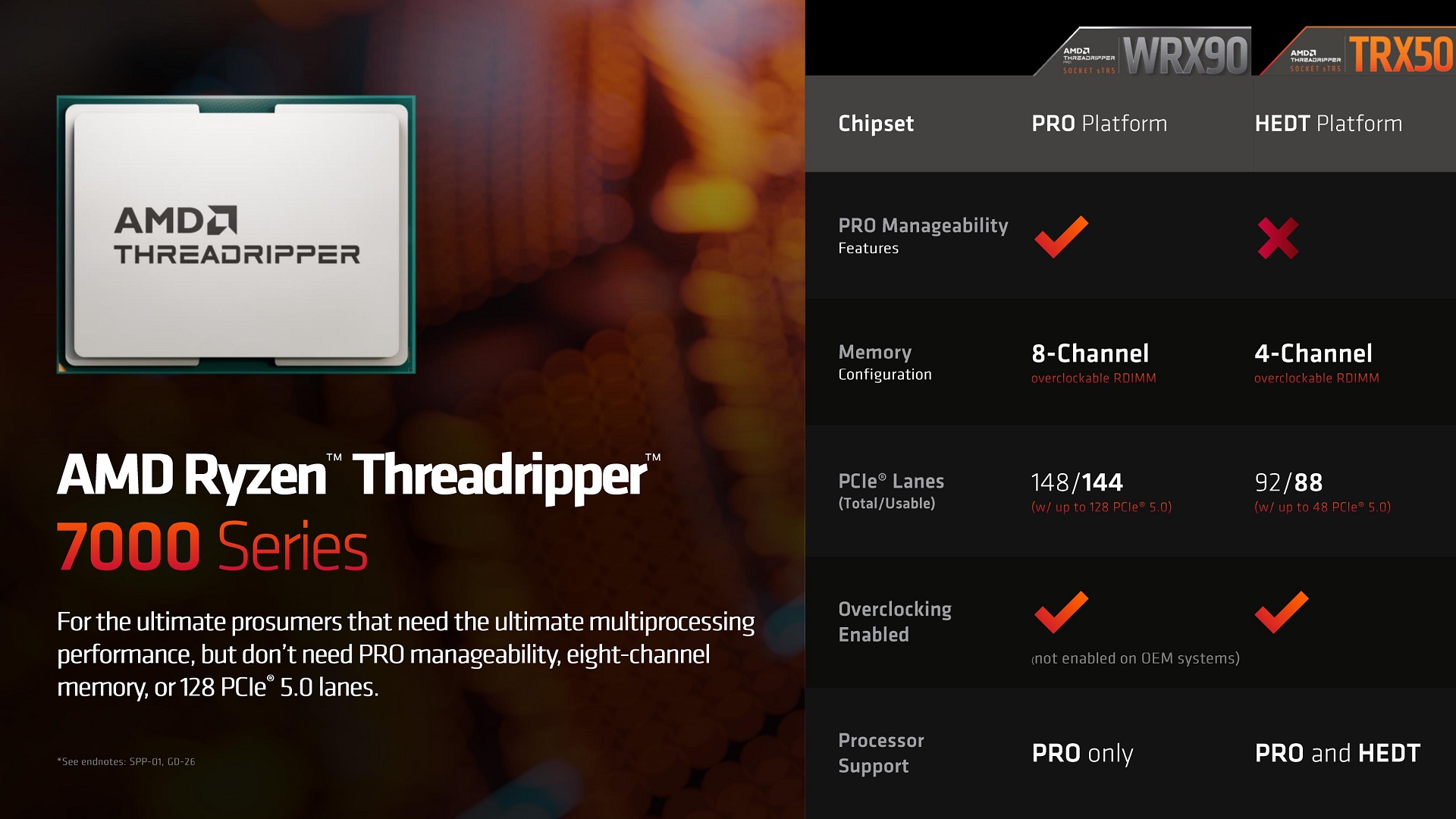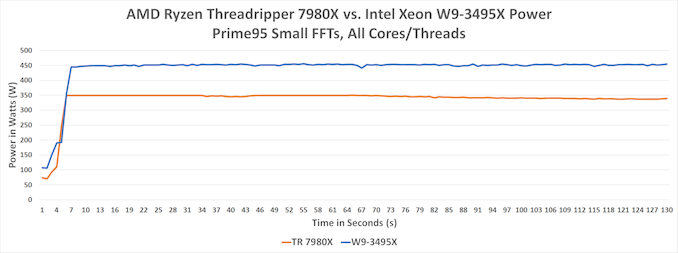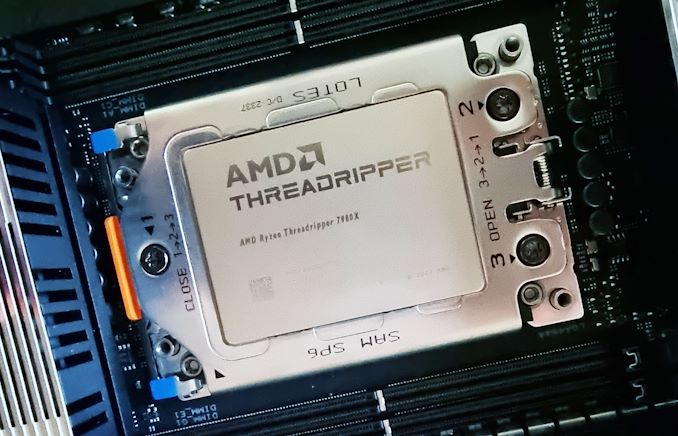
Original Link: https://www.anandtech.com/show/21124/amd-ryzen-threadripper-7980x-and-7970x-review
AMD Ryzen Threadripper 7980X & 7970X Review: Revived HEDT Brings More Cores of Zen 4
by Gavin Bonshor on November 20, 2023 9:00 AM EST- Posted in
- CPUs
- AMD
- HEDT
- ThreadRipper
- Zen 4
- Threadripper 7000
- TRX50
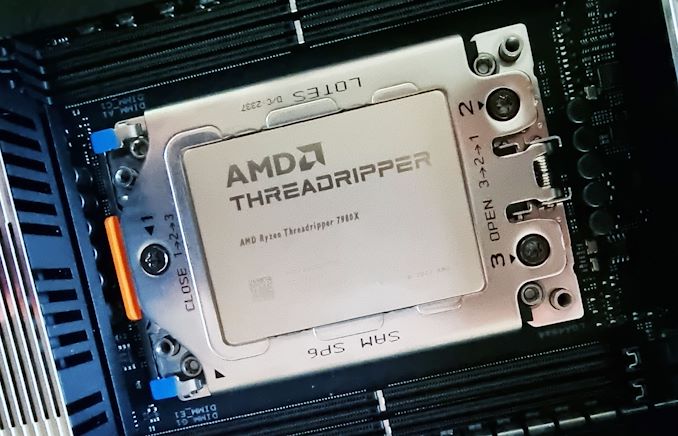
AMD's Ryzen Threadripper 7000 processors mark the latest additions to the high-end desktop (HEDT) market, a segment AMD wants to bring back to the mainstream. Based on AMD's proven Zen 4 architecture and built on TSMC's 5nm process, both of AMD's new Ryzen Threadripper 7000 lineups – Pro and non-Pro – are designed to bring more cores and more I/O to the high-end desktop and workstation markets. Altogether, AMD is offering three new Ryzen Threadripper 7000 SKUs, the top-end 7980X with 64 cores, the mid-tier 7970X with 32 cores, and the entry-level chip in the line-up, the 24-core 7960X.
As has been the case for the vanilla Threadripper series since its inception, the purpose of AMD's server-derived processors is to meet the demands of desktop users who require extreme multitasking capabilities and high throughput for complex workloads, offering more CPU cores, more memory channels, and more PCIe lanes than what otherwise comes with AMD's desktop platform. At the same time, the basic Threadripper lineup differentiates itself from the professional workstation-focused Threadripper Pro chips – in this case, AMD's new Threadripper 7000 WX-series – by leaving out some of the more 'Pro' features that come with that hardware, as well as some of the CPU/memory/IO hardware that the even more powerful Pro chips offer. Segmenting both product lines is a good idea, given the pedigree and use cases of both the Pro WX-series and non-Pro chips are aligned with. With Threadripper 7000, AMD targets customer bases that need CPUs more powerful than a desktop Ryzen processor but not as exotic (or expensive) as what's essentially a full server-grade chip.
After taking a break in the previous generation, AMD is once again offering a HEDT-focused line-up to consumers, which is as grandiose as it is interesting. When AMD launched the Zen 3-based Threadripper 5000 series, AMD only ever released the workstation-focused Pro parts, leaving users looking for semi-affordable high-core count CPUs in the dust. This time, AMD has decided to bring the HEDT back, creating a pair of Threadripper lines similar to the Threadripper 3000 family in 2019.
Today in our AMD Ryzen Threadripper 7000 series review, we're going to be focusing on the top two chips from the trifecta, the top-end Ryzen Threadripper 7980X (64C/128T) and the middle of the road 7970X (32C/64T). We'll be comparing them to the previous Ryzen Threadripper 3000 series and directly against Intel's Sapphire Rapids Workstation CPUs, including the flagship Intel Xeon w9-3495X. Also, we'll be putting them against the desktop flagships, such as the Intel Core i9-14900K and the AMD Ryzen 9 7950X, to see how much more performance AMD's new foray into HEDT users can squeeze out. Is there a suitable place in the market for HEDT chips, given how far desktop processors have progressed within the last couple of years? Let's find out.
AMD Ryzen Threadripper 7000 Series: Bringing HEDT Back
After AMD skipped releasing a vanilla Threadripper processor as part of their Zen 3 architecture family – what would have been the Ryzen Threadripper 5000 series – things certainly looked dim for the future of the high-end desktop (HEDT) market. Combined with Intel also skipping HEDT that generation by not bringing down their troubled Ice Lake server silicon to HEDT products, and it was looking like HEDT may have finally been pushed out by more powerful desktop processors. But a generation later, and things have seemingly changed for the better for the HEDT market. Looking to further capitalize on the success of their Zen 4 architecture, AMD is bringing back HEDT models to the market via the Threadripper 7000 series, with three new chips ranging up to 64C/128T, all with full Zen 4 cores.
The AMD Ryzen Threadripper 7980X, 7970X, and 7960X are the latest entries in the HEDT market, bringing significant advancements in processing power and efficiency. The 7980X is the top SKU with 64 cores/128 threads, a turbo clock speed of up to 5.1 GHz, and a base clock of 2.5 GHz. The 7970X has half the cores and threads, for 32 cores/64 threads altogether, and offers a higher base frequency of 3.2 GHz and matches its higher-end counterpart's 5.1 GHz turbo clock.
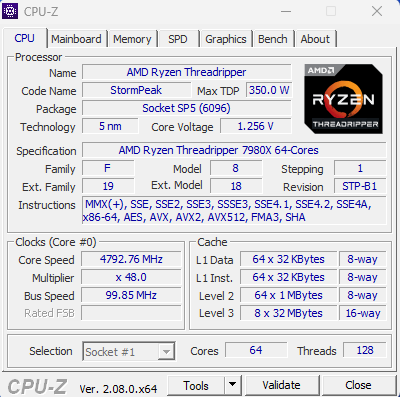
AMD Ryzen Threadripper 7980X (64C/128T) CPU-Z Screenshot
These chips are aimed at driving demanding multi-threaded applications that can saturate high core count CPUs, such as advanced content creation, 3D rendering, and complex computational tasks. The 7980X, the more powerful of the two, is particularly suited for scenarios requiring extreme multitasking and high throughput.
Conversely, though AMD isn't sampling it for today's review embargo, the Threadripper 7960X represents the other side of the coin. With 24 cores/48 threads, a base frequency of 3.2 GHz and a turbo clock speed of up to 5.3 GHz, the 7960X offers the fewest cores, but still all of the memory bandwidth and I/O lanes the Threadripper platform can provide, making it especially well suited for tasks where data throughput rather than raw CPU performance is the bottleneck. Still, with fewer CPU cores, it's the entry-level part (if you can call it that) to AMD's new HEDT platform, with an MSRP of $1499.
| AMD Ryzen Threadripper 7000 (Zen 4) | ||||||||
| AnandTech | Cores | Base Freq |
Turbo Freq |
PCIe (Gen 5) |
Cache (L3) |
TDP | DRAM (RDIMM) |
Price ($) |
| 7980X | 64 / 128 | 2500 | 5100 | 48 | 256 MB | 350W | 4 x DDR5-5200 | $4999 |
| 7970X | 32 / 64 | 3200 | 5100 | 48 | 128 MB | 350W | 4 x DDR5-5200 | $2499 |
| 7960X | 24 / 48 | 3200 | 5300 | 48 | 128 MB | 350W | 4 x DDR5-5200 | $1499 |
Regarding memory and I/O capabilities, the Threadripper 7000 series supports quad-channel DDR5 memory and up to 48 PCIe 5.0 lanes, offering plenty of bandwidth for devices such as storage and graphics. Unique to the Threadripper 7000 platform (versus AMD's consumer platform), AMD supports RDIMMs here, allowing the for support for up to 1 TB of memory via DDR-5200 RDIMMs – over 5x as much memory as desktop Ryzen.
These processors represent AMD's commitment to pushing the capability of desktop computing power, catering to both professionals, enthusiasts, and everything in between. They are designed for users who require more than what standard desktop CPUs can offer. The Ryzen Threadripper 7980X and 7970X are designed to excel in multi-threaded workloads. Their theoretical ability to handle more diverse and intensive workloads than desktop processors makes them a pivotal choice in the current HEDT landscape.
One step above this is the Threadripper 7000 Pro WX series, which has support for 8 channels of memory, pushing the performance where workloads, instruction sets, and applications can benefit from both more memory bandwidth and higher memory densities.
The TRX50 Chipset: Designed For Threadripper 7000, Supports TR Pro 7000 WX-Series
Launching alongside the new Threadripper chips is AMD's TRX50 chipset. The TRX50 platofrm uses the new 4844 pins sTR5 socket, which like the Threadripper processors themselves, is derived from AMD's EPYC offerings – in this case the SP6 socket AMD introduced for their lower-priced EPYC 8004 (Siena) processors. Despite the identical pin count, it should be noted that sTR5 and SP6 are not pin compatible.
Meanwhile, looking at things on a generational basis, there is a degree of cooler compatibility. Specifically, older socket sTRX4 Threadripper coolers will still fit on the 58.5mm x 75.4mm sTR5 socket. This means users upgrading from sTRX4 chips should theoretically be able to recycle their old cooler. However, they would certainly need to be capable of supporting a higher TDP of 350 W.
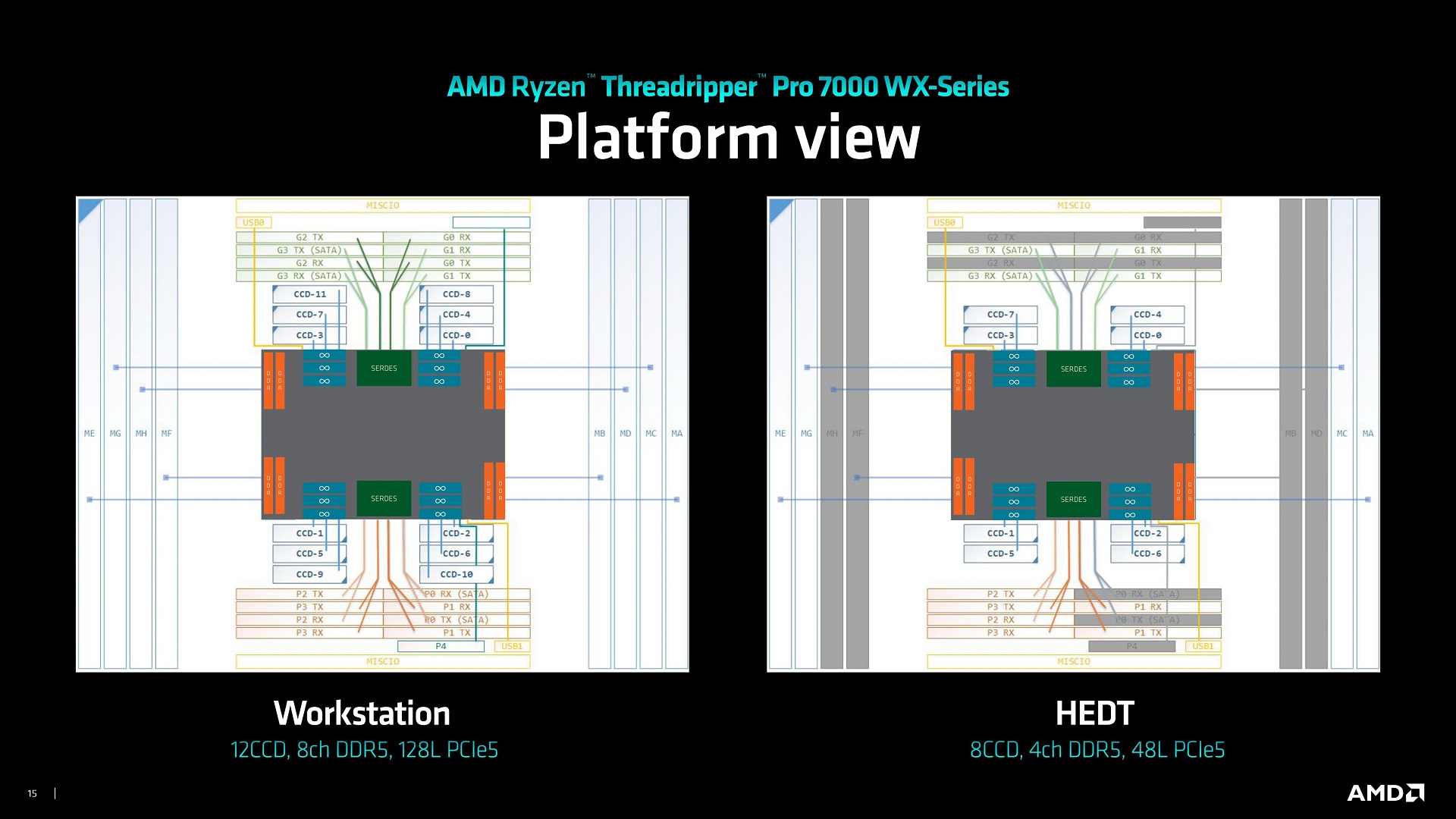
Platform diagram of the WRX90 (left) and TRX50 (right)
For memory and I/O, the TRX50 platform supports 4-channel DDR5 memory and 80 PCIe lanes. Though the latter ends up being an unexpected mix of PCIe 5.0 lanes and PCIe 4.0 lanes, with 48x PCIe 5.0 lanes alongside a further 32x PCIe 4.0 lanes. As PCIe Gen5 is more complex to implement and longer runs require re-drivers, AMD has opted to limit the manufacturing costs of motherboards by not running quite so many max-speed PCIe lanes. At the same time, the idea of TRX50, especially when directly compared to WRX90 for Threadripper Pro 7000 WX-series chips, is that it is a cut-down version to provide everything users need on a middle-abridged chipset between desktop AM5 and WRX90 – meaning that dialing back some PCIe lanes to 4.0 also provides some feature differentiation between the two Threadripper lineups.
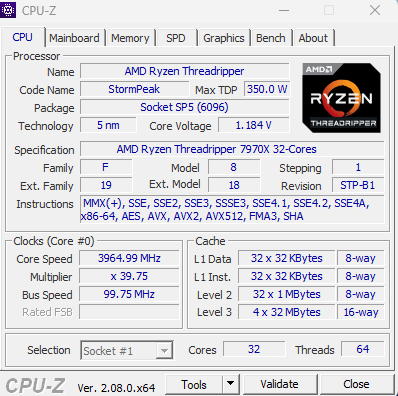
AMD Ryzen Threadripper 7970X (32C/64T) CPU-Z Screenshot
It is worth highlighting that Threadripper 7000 Pro chips can also be used in TRX50 motherboards. But, of course, they will be subjected to the same memory channel and I/O limitations. In that respect, TRX50 boards can be used as a budget board pairing for Threadripper Pro chips. Otherwise, the converse is false: non-pro Threadripper 7000 chips cannot be used in WRX90 boards, as illogical as that would be.
Test Bed and Setup
We use the following test systems for our AMD Ryzen Threadripper 7980X, 7970X, and Intel Xeon WS-series testing:
| AMD Ryzen Threadripper 7000 Series | Intel Sapphire Rapids Xeon Series | |
| CPU | Ryzen Threadripper 7980X ($4999) 64 Cores, 128 Threads 350 W TDP Ryzen Threadripper 7970X ($2499) 32 Cores, 64 Threads 350 W TDP |
Xeon W9-3495X ($5889) 56 Cores, 112 Threads 350 W TDP |
| Motherboard | ASUS Pro WS TRX50-SAGE WIFI | ASUS Pro WS W790E-SAGE SE |
| Memory | G.Skill Zeta R5 Neo 4x32 GB DDR5-5200 RDIMM |
SK Hynix 8x16 GB DDR5-4800 RDIMM |
| 6 | NZXT Kraken 360 360mm AIO | Noctua NH-U14S DX-4677 |
| Storage | SK Hynix Platinum P41 2TB PCIe 4.0 x4 | |
| Power Supply | MSI A1000G 1000W | |
| GPUs | AMD Radeon RX 6950 XT, 31.0.12019 | |
| Operating Systems | Windows 11 22H2 | |
For our head-to-head comparison, we have on hand Intel's latest Sapphire Rapids Xeons. Like the Threadripper series, the Xeons are split up into two sub-groups – the full-fat Xeon w-3000 series for high-end workstations, and the lighter Xeon w-2000 series for more mainstream workstations. Unfortunately, the only Xeons we have on hand are the w-3000 series parts (which is what Intel sampled for reviewing when those were released), so it's not quite an apples-to-apples comparison, especially as the w-3000 Xeons support 8 channels of memory (versus TR's 4 channels).
Still, there are similarities in core and thread count and TDP that should offer some enlightening data. Both platforms have a max TDP of 350W, and the Intel W9-3495X we're using is a 56C/112T chip, while the Threadripper 7980X is a 64C/128T chip.
For added flavor, we'll be adding in data from both AMD and Intel's flagship desktop processors, including the Core i9-14900K, the Ryzen 9 7950X, and Ryzen 9 7950X3D. We will also be comparing the new AMD Threadripper 7000 series chips to their previous counterparts, including the AMD Ryzen Threadripper 3990X (64C/128T), which we reviewed in 2020, as well as the Threadripper 3970X (32C/64T).
Read on for our extended analysis.
SPEC2017 Single-Threaded Results
SPEC2017 is a series of standardized tests used to probe the overall performance between different systems, different architectures, different microarchitectures, and setups. The code has to be compiled, and then the results can be submitted to an online database for comparison. It covers a range of integer and floating point workloads, and can be very optimized for each CPU, so it is important to check how the benchmarks are being compiled and run.
We run the tests in a harness built through Windows Subsystem for Linux, developed by Andrei Frumusanu. WSL has some odd quirks, with one test not running due to a WSL fixed stack size, but for like-for-like testing it is good enough. Because our scores aren’t official submissions, as per SPEC guidelines we have to declare them as internal estimates on our part.
For compilers, we use LLVM both for C/C++ and Fortan tests, and for Fortran we’re using the Flang compiler. The rationale of using LLVM over GCC is better cross-platform comparisons to platforms that have only have LLVM support and future articles where we’ll investigate this aspect more. We’re not considering closed-source compilers such as MSVC or ICC.
clang version 10.0.0
clang version 7.0.1 (ssh://git@github.com/flang-compiler/flang-driver.git
24bd54da5c41af04838bbe7b68f830840d47fc03)
-Ofast -fomit-frame-pointer
-march=x86-64
-mtune=core-avx2
-mfma -mavx -mavx2
Our compiler flags are straightforward, with basic –Ofast and relevant ISA switches to allow for AVX2 instructions.
To note, the requirements for the SPEC licence state that any benchmark results from SPEC have to be labeled ‘estimated’ until they are verified on the SPEC website as a meaningful representation of the expected performance. This is most often done by the big companies and OEMs to showcase performance to customers, however is quite over the top for what we do as reviewers.
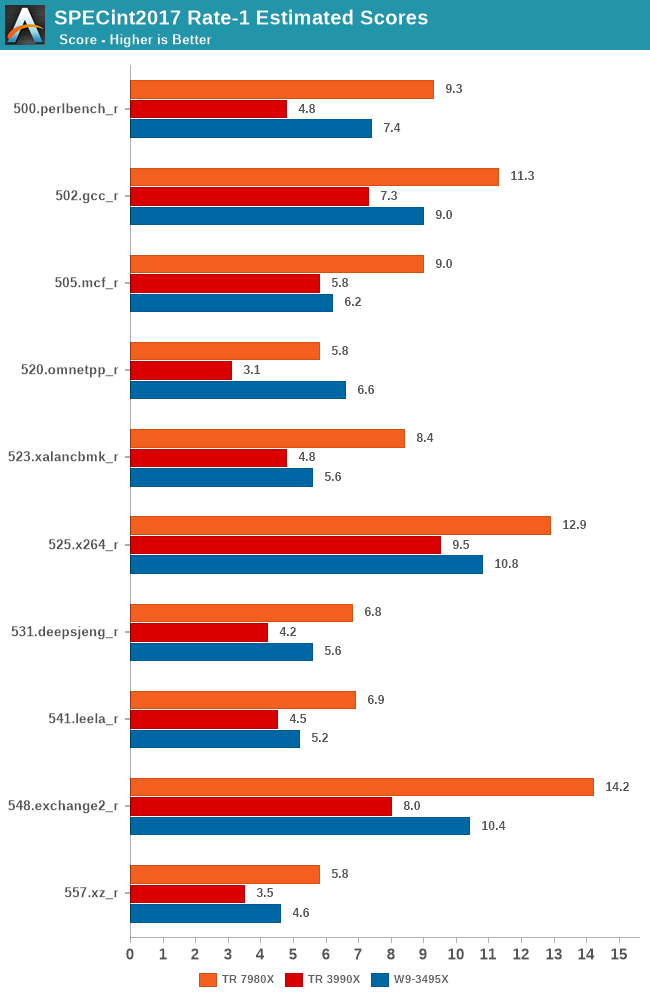
Opening up our performance analysis of the Ryzen Threadripper 7980X in SPEC2017 1T, as we typically do, we split the results between SPECint2017 and SPECfp2017. Starting with SPECint2017, we can see clear gains in the Ryzen Threadripper 7980X (Zen 4) compared to the previous Threadripper 3990X processor (Zen 2). Given the generational gap between the two core architectures, AMD never released regular HEDT-focused Zen 3 Threadripper processors.
In the majority of our tests, we're seeing single-threaded performance gains of between 65 and 93% within the 500.perlbench_r test of the SPECint2017 1T suite provided the largest gain in ST performance we saw. Looking at how the Intel Xeon W9-3495X performed in SPECint2017, lower single-threaded performance is expected due to the slower core frequencies, and our data shows this. It still puts it ahead of the Ryzen Threadripper 3990X in each scenario, but the Ryzen Threadripper 7980X performs best of all.
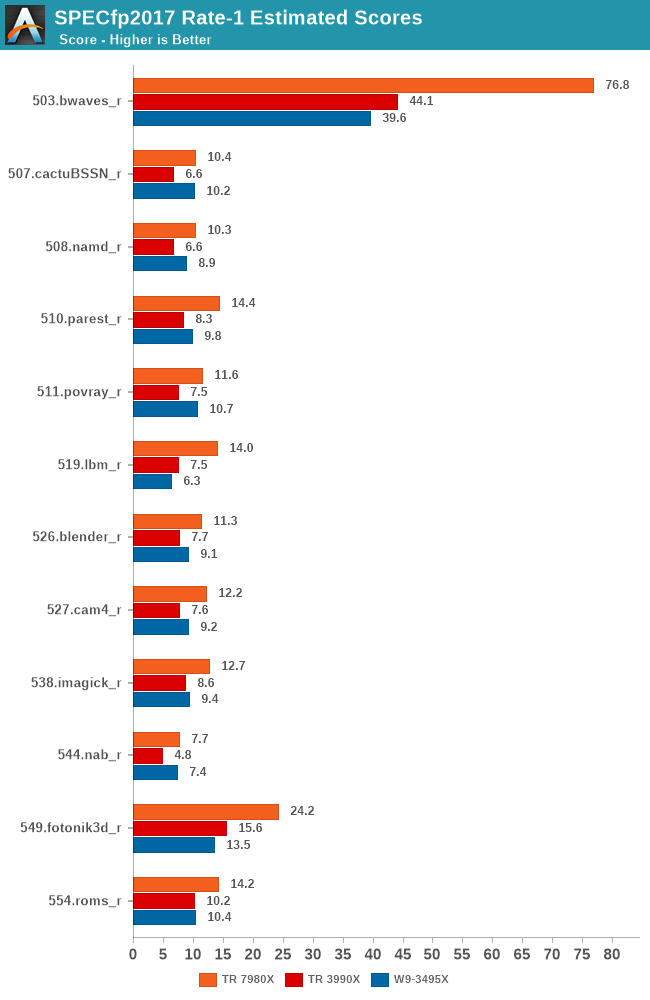
Focusing on the second half of our SPEC2017 1T suite, the SPECfp2017 section, we can see that although the performance gap between the Threadripper 7980X isn't as big as SPECint2017 1T, it still represents solid generational gains over the 3990X. The SPECfp2017 1T section of the suite also puts the Intel Xeon W9-3495X closer to the older Threadripper 3990X, which can, again, be explained due to the much slower core frequencies, e.g., 1.9 G base, 3.4 G turbo vs. 2.9 G base, 4.3 G turbo.
Overall, in SPEC2017 1T, the AMD Ryzen Threadripper 7000 represents significant single-threaded gains over the Threadripper 3990X, but we expected this given the generational jump between the two processors.
SPEC2017 Multi-Threaded Results
Note: We are currently running SPEC2017 on the AMD Ryzen Threadripper 7980X, and we will update this page with our results as soon as we have them. As such, this page serves as a placeholder.
Single-threaded performance is only one element regarding performance on a multi-core processor, and it's time to look at multi-threaded performance in SPEC2017.
Core-to-Core Latency
As the core count of modern CPUs is growing, we are reaching a time when the time to access each core from a different core is no longer a constant. Even before the advent of heterogeneous SoC designs, processors built on large rings or meshes can have different latencies to access the nearest core compared to the furthest core. This rings true especially in multi-socket server environments.
But modern CPUs, even desktop and consumer CPUs, can have variable access latency to get to another core. For example, in the first generation Threadripper CPUs, we had four chips on the package, each with 8 threads, and each with a different core-to-core latency depending on if it was on-die or off-die. This gets more complex with products like Lakefield, which has two different communication buses depending on which core is talking to which.
If you are a regular reader of AnandTech’s CPU reviews, you will recognize our Core-to-Core latency test. It’s a great way to show exactly how groups of cores are laid out on the silicon. This is a custom in-house test, and we know there are competing tests out there, but we feel ours is the most accurate to how quick an access between two cores can happen.
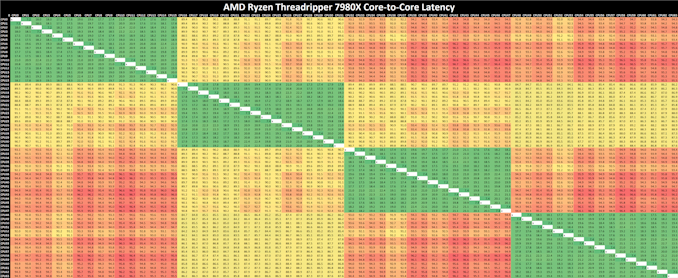
(Click on the image to enlarge)
Analyzing core-to-core latencies on the AMD Ryzen Threadripper 7980X (64C/128T), our test is limited to probing the first 64 threads, although scaling out to 128 threads would be identical. Each CCD on the Threadripper 7980X has 8 x Zen 4 cores, with 32 MB of L3 cache. Looking at the latency range within the CCD, we can see inner latencies between 7 and 20 ns, which increase to 89 and 96 ns as each core communicates within the CCX.
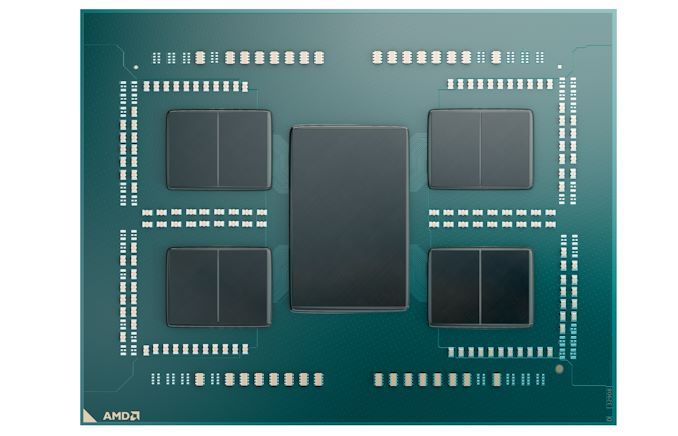
A visual render of the AMD Ryzen Threadripper 7980X with 8 x CCDs and IOD
Given we've reviewed the AMD Ryzen 9 7950X, which has the same Zen 4 cores and the same CCD complex approach to communicating between the cores, we see relatively similar latencies in both Threadripper 7000 and Ryzen 7000. A quad-channel DDR5 memory controller integrated within the large IOD and using PCIe 5.0 lanes as the primary pathway is important in enhancing the Infinity Fabric interconnect to reduce latencies and help counteract any penalties.
Threadripper 7000 vs. Threadripper 3000: Generational Improvements
Looking at how the latest AMD Ryzen Threadripper 7000 series processors compare against the previous Threadripper 3000 series, we are essentially testing apples against apples (or older apples). Both sets of Threadripper CPUs share the same core/thread counts, including the 7980X and 3990X, which both have 64C/128T, albeit being Zen 4 vs Zen 2, given AMD didn't launch non-Pro SKUs for the 5000 series. The same can be said with the 7970X and 3970X, which are both 32C/64T chips.
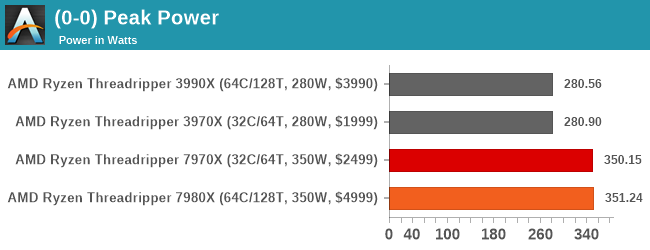
All four of the AMD Ryzen Threadrippers hit a max power in line with their rated TDPs, including 280 W for the 3000 series and 350 W for the 7000 series.
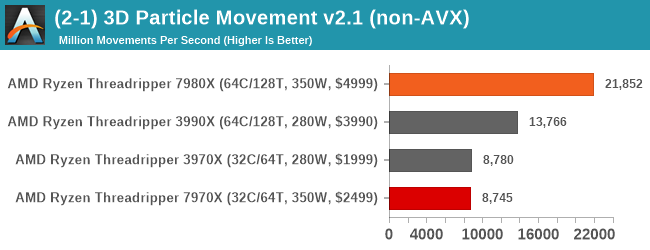
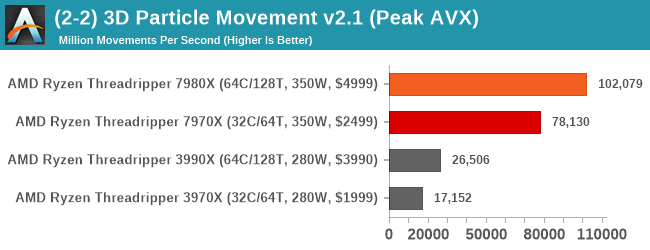
In 3DPM V2.1, it's worth highlighting that AMD's Ryzen Threadripper 3000 series doesn't support AVX 512/AV2 workloads. Given that AMD's Ryzen Threadripper 7000 series does, it means that performance in comparison is much higher as expected in this benchmark.

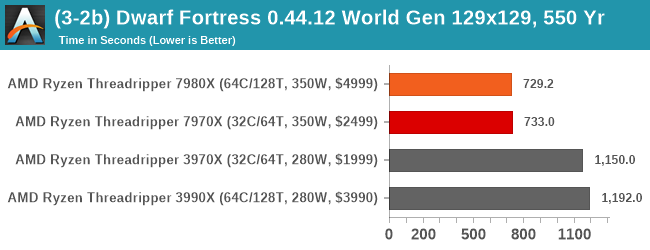
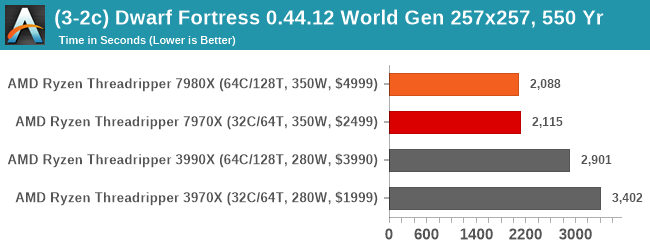
In Dwarf Fortress, the AMD Ryzen Threadripper 7000 series CPUs (7980X and 7970X) run much faster in this benchmark than the 3000 series. In the larger of the three tests, the 7980X is around 39% faster than the 3990X, showing that Zen 4 versus Zen 2 is very beneficial.
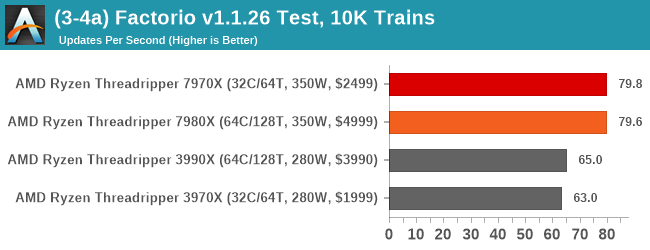
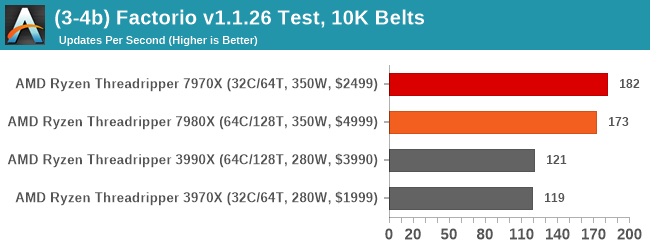

In Factorio, both the Ryzen Threadripper 7000 series chips perform similarly here, although are around 30% faster than the 3000 series.
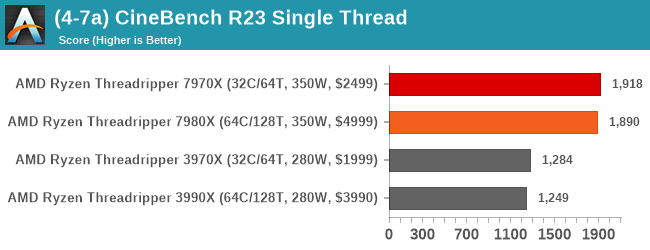
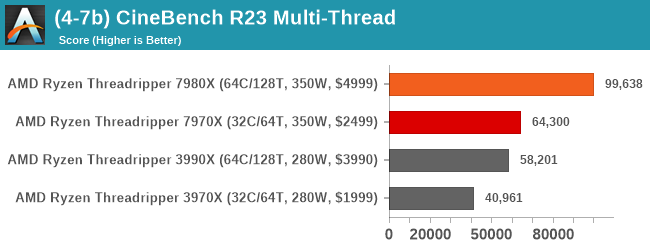
Looking at CineBench R23 single-threaded performance, there are substantial gains going from Zen 2 to Zen 4, as expected. In the CineBench R23 multi-threaded benchmark, we can see that even the Threadripper 7970 (32C/64T) is 10% faster than the 3990X, which is a 64C/128T part. The Ryzen Threadripper 7980X decimates the other three chips with a gain of 71% over the previous generation chip with the same core/thread count.
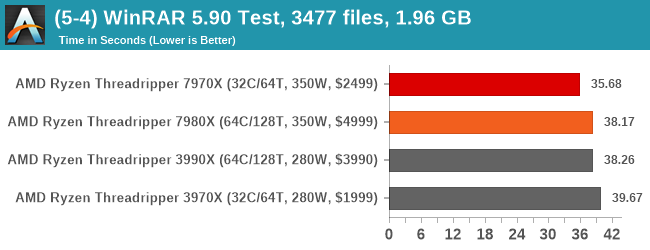
While our WinRAR 5.90 benchmark is quite sensitive to memory performance, the Threadripper 7970X beats the 7980X, while both are marginally ahead of the Threadripper 3000 series chips.
Overall, as we can see regarding rendering and simulation performance, the AMD Ryzen Threadripper 7000 chips are both vastly superior to the 3000 series chips. It does have to be said that Threadripper 7000 is two generations of cores ahead of the 3000 series (Zen 4 vs Zen 2), as AMD didn't launch non-Pro 5000 series SKUs. Users looking to update from the Threadripper 3000 series platform for HEDT will certainly see benefits across the board opting to elect for Ryzen Threadripper 7000.
TR 7000 vs. Intel: Power and Compile
Our previous sets of ‘office’ benchmarks have often been a mix of science and synthetics, so this time, we wanted to keep our office and productivity section purely based on real-world performance. We've also incorporated our power testing into this section. Given the nature and target market of the Ryzen Threadripper 7000 series, we've opted to focus on tasks such as compiling.
We are using DDR5-5200 RDIMM memory on the Ryzen Threadripper 7980X and 7970X as per JEDEC specifications. For Intel's Xeon W9-3495X, we are using DDR5-4800 RDIMM memory as per Intel's JEDEC specifications. It should be noted that both platforms are run with their full allocation of memory channels, e.g., TR7000 in 4-channel and Sapphire Rapids in 8-channel.
Below are the settings we have used for each platform:
- DDR5-5200 RDIMM - AMD Threadripper 7000
- DDR5-4800 RDIMM - Intel Xeon Sapphire Rapids WS
- DDR5-5600B CL46 - Intel 14th Gen
- DDR5-5200 CL44 - Ryzen 7000
Power
The nature of reporting processor power consumption has become, in part, a bit of a nightmare. Historically the peak power consumption of a processor, as purchased, is given by its Thermal Design Power (TDP, or PL1). For many markets, such as embedded processors, that value of TDP still signifies the peak power consumption. For the processors we test at AnandTech, either desktop, notebook, or enterprise, this is not always the case.
Modern high-performance processors implement a feature called Turbo. This allows, usually for a limited time, a processor to go beyond its rated frequency. Exactly how far the processor goes depends on a few factors, such as the Turbo Power Limit (PL2), whether the peak frequency is hard coded, the thermals, and the power delivery. Turbo can sometimes be very aggressive, allowing power values 2.5x above the rated TDP.
AMD and Intel have different definitions for TDP that are, broadly speaking, applied the same. The difference comes from turbo modes, turbo limits, turbo budgets, and how the processors manage that power balance. These topics are 10000-12000 word articles in their own right, and we’ve got a few articles worth reading on the topic.
- Why Intel Processors Draw More Power Than Expected: TDP and Turbo Explained
- Talking TDP, Turbo and Overclocking: An Interview with Intel Fellow Guy Therien
- Reaching for Turbo: Aligning Perception with AMD’s Frequency Metrics
- Intel’s TDP Shenanigans Hurts Everyone
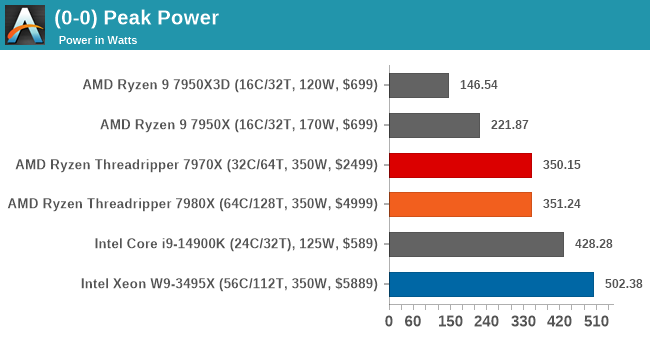
Looking at the max power we observed on the AMD Ryzen Threadripper 7980X and 7970X processors, we can see they hit and don't go robustly above their rated TDPs of 350 W. In contrast, the Intel Xeon W9-3495X peaked at a huge 502 W, well above the rated 350 W TDP. Compared to the desktop processors we've added to the data set, both Threadripper 7000 series processors are also considerably below the Intel Core i9-14900K.
Moving onto a deeper look at how the AMD Ryzen Threadripper 7980X compares to the Intel Xeon W9-3495X in Prime95 with Small FFTs, we can see that Intel's Sapphire Rapids WS option draws considerably more power. Despite having eight more cores than the W9-3495X, the Threadripper 7980X runs consistently within AMD's designated TDP of 350W; this is the TDP for all three AMD Ryzen Threadripper 7000 series SKUs. As we've highlighted in our desktop reviews of the Ryzen 9 7950X and Ryzen 9 7950X3D processors, we know AMD's Zen 4 core doesn't only deliver in performance, but it's a highly efficient core, too.
Compile/Database
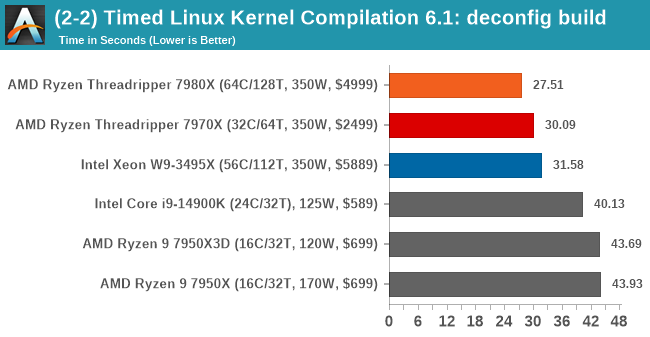
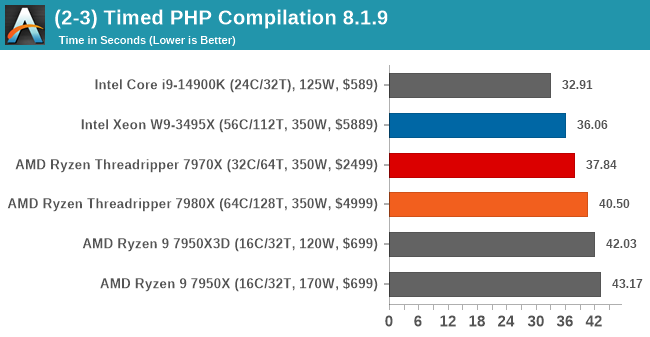
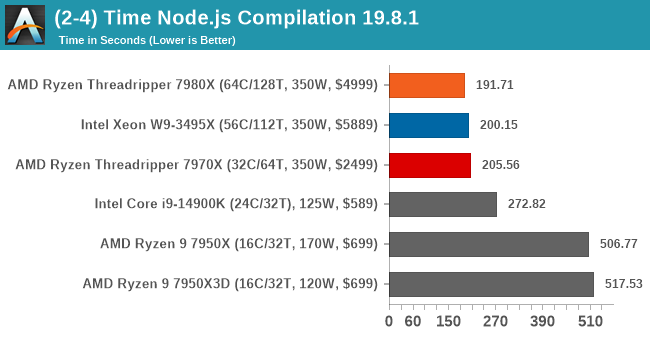
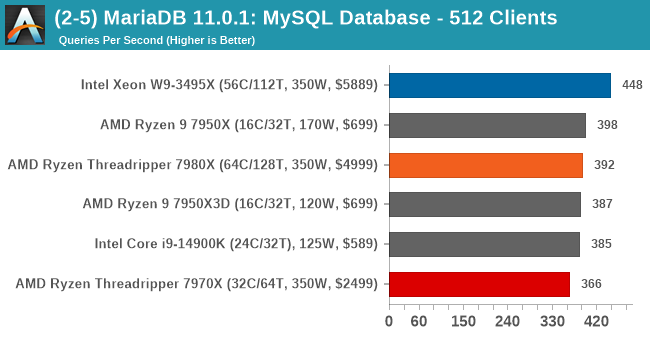
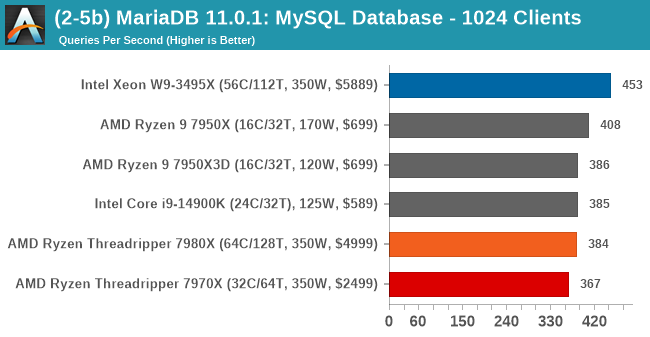
In our timed compilation benchmarks, including Linux Kernel, PHP, and Node.js, we can see that the Threadripper 7980X and 7970X perform well for the most part. In larger compilations such as Node.js, there's a significant advantage to having a higher core/thread count. Intel's Xeon W9-3495X beats all the chips we tested convincingly in the MariaDB MySQL database benchmark, with the flagship desktop chips also performing well here.
TR 7000 vs. Intel: Encoding
One of the interesting elements of modern processors is encoding performance. This covers two main areas: encryption/decryption for secure data transfer and video transcoding from one video format to another.
In the encrypt/decrypt scenario, how data is transferred and by what mechanism is pertinent to on-the-fly encryption of sensitive data - a process by which more modern devices are leaning towards for improving software security.
We've updated our list of encoding benchmarks for our 2024 CPU suite to include some of the most relevant and recent codecs, such as AV1, HEVC, and VP9. Not only this, but we have also included FLAC audio encoding as well as WebP2 image encoding into the mix to show not only how the latest processors perform with these codecs but also to show discrepancies in performance throughout the different segments.
We are using DDR5-5200 RDIMM memory on the Ryzen Threadripper 7980X and 7970X as per JEDEC specifications. For Intel's Xeon W9-3495X, we are using DDR5-4800 RDIMM memory as per Intel's JEDEC specifications. It should be noted that both platforms are run with their full allocation of memory channels, eg, TR7000 in 4-channel and Sapphire Rapids in 8-channel.
Below are the settings we have used for each platform:
- DDR5-5200 RDIMM - AMD Threadripper 7000
- DDR5-4800 RDIMM - Intel Xeon Sapphire Rapids WS
- DDR5-5600B CL46 - Intel 14th Gen
- DDR5-5200 CL44 - Ryzen 7000
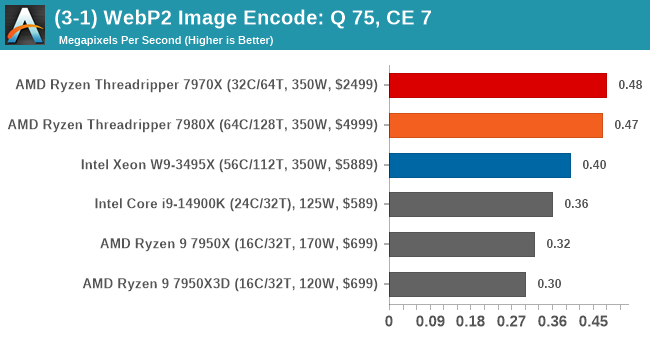
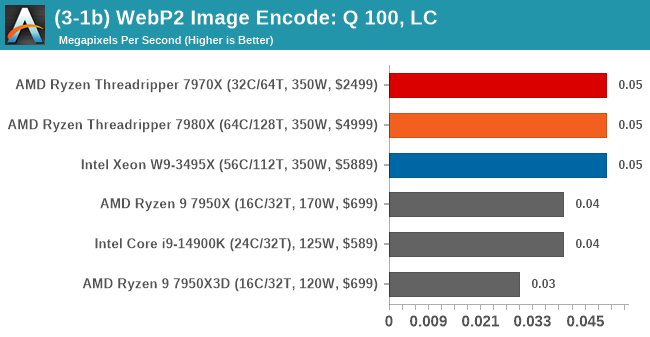
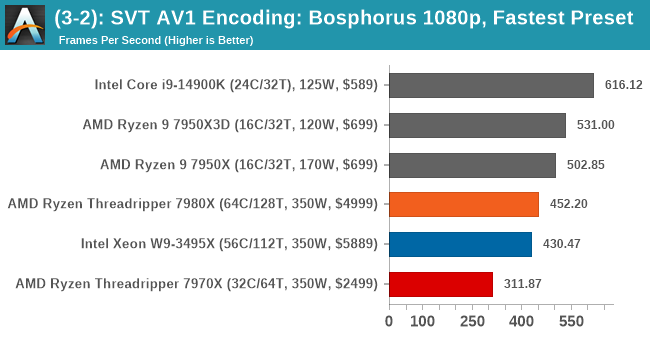
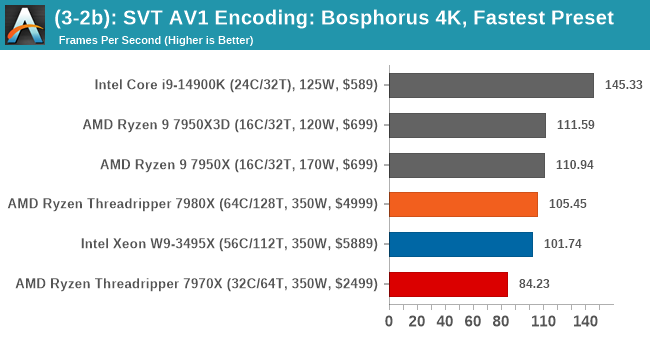
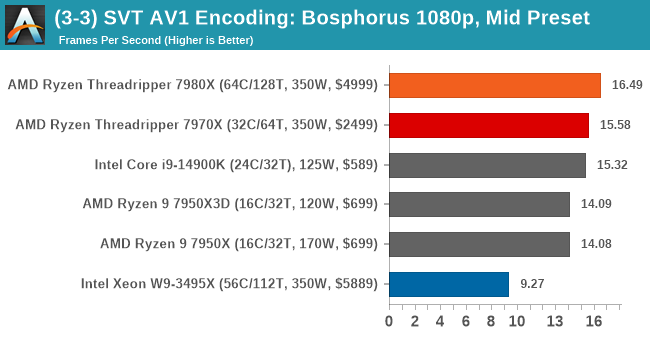
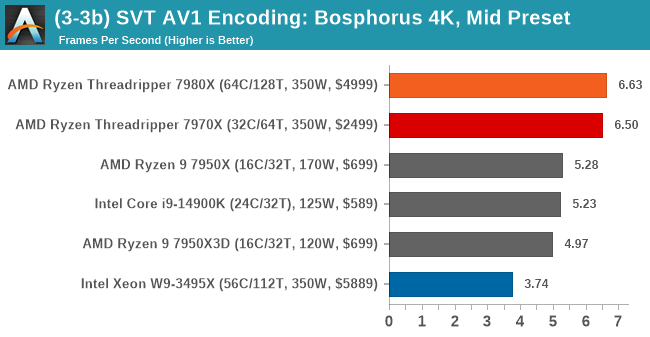
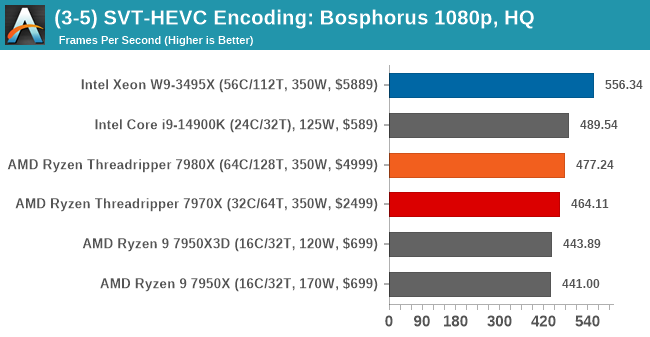

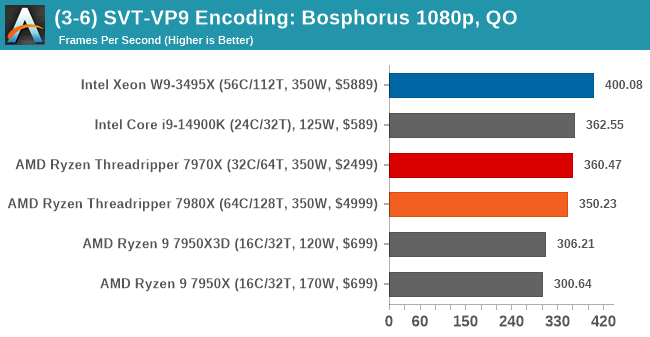
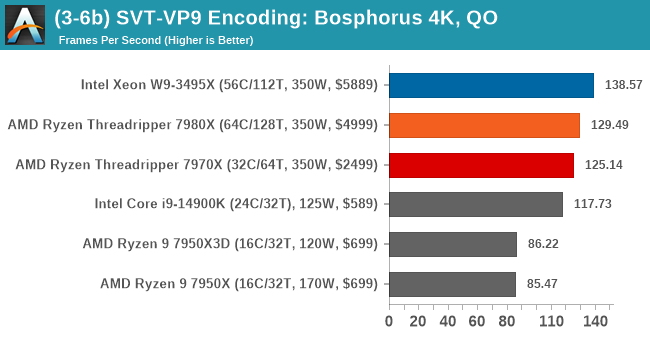
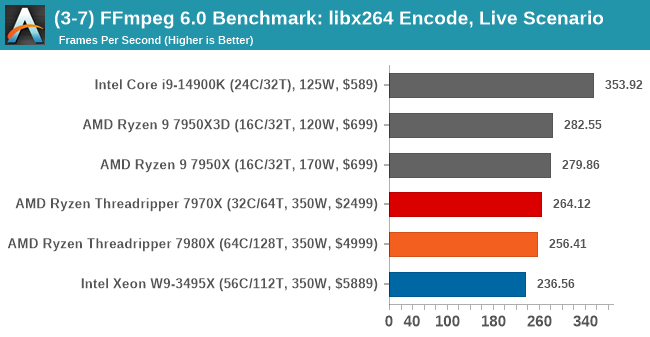

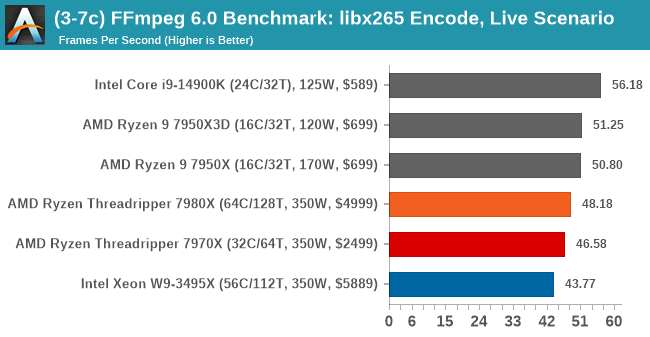
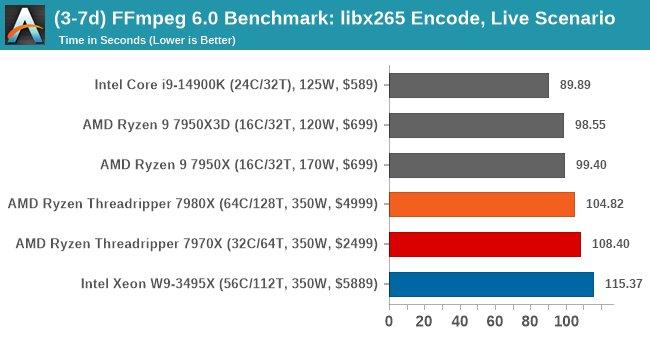
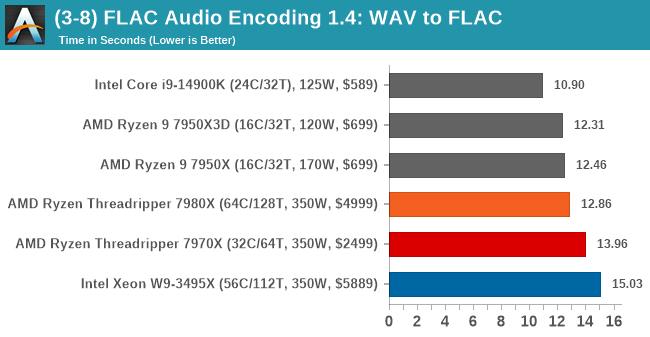
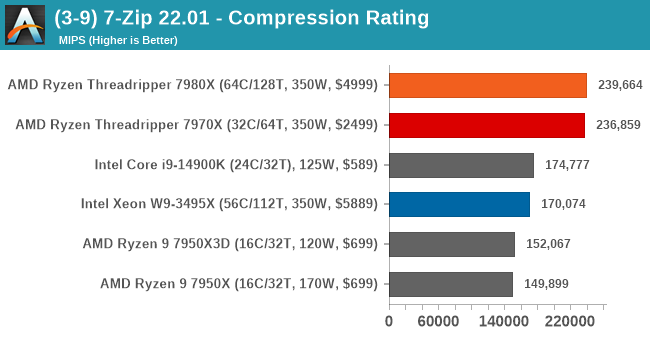
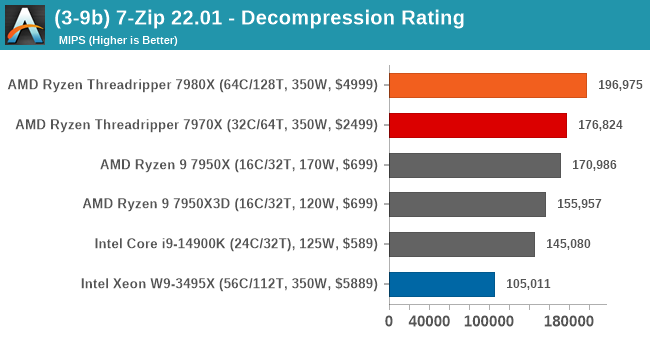
Starting with the WebP2 Image encoding tests, the Ryzen Threadripper 7980X and 7970X perform well compared to the other chips we've tested. Interestingly, in the SVT AV1 encoding using the fastest preset, the desktop chips with the faster core frequencies win. The tables turn using the mid preset, with both Threadripper 7000 chips sitting on top of the charts.
In the SVT-HEVC benchmark, the Intel Xeon W9-3495X sits at the top of the list, and the same is prevalent in the VP9 encoding benchmark. In the FFmpeg 6.0 benchmark with x264 and x265, the desktop processors with the faster cores win in this situation, with the Core i9-14900K and the 6.0 GHz boost core frequencies playing a bigger hand than simply having more cores.
Looking at 7-Zip performance, both the Threadripper 7980X and 7970X are vastly superior to the Intel Xeon W9-3475X and the flagship desktop chips, including the Core i9-14900K, Ryzen 9 7950X, and Ryzen 9 7950X3D.
TR 7000 vs. Intel: Rendering
Rendering tests, compared to others, are often a little more simple to digest and automate. All the tests put out some sort of score or time, usually in an obtainable way that makes it fairly easy to extract. These tests are some of the most strenuous in our list, due to the highly threaded nature of rendering and ray-tracing, and can draw a lot of power.
If a system is not properly configured to deal with the thermal requirements of the processor, the rendering benchmarks are where it would show most easily as the frequency drops over a sustained period of time. Most benchmarks, in this case, are re-run several times, and the key to this is having an appropriate idle/wait time between benchmarks to allow for temperatures to normalize from the last test.
Some of the notable rendering-focused benchmarks we've included for 2024 include the latest CineBench 2024 benchmark and an update to Blender 3.6 and V-Ray 5.0.2.
We are using DDR5-5200 RDIMM memory on the Ryzen Threadripper 7980X and 7970X as per JEDEC specifications. For Intel's Xeon W9-3495X, we are using DDR5-4800 RDIMM memory as per Intel's JEDEC specifications. It should be noted that both platforms are run with their full allocation of memory channels, eg, TR7000 in 4-channel and Sapphire Rapids in 8-channel.
Below are the settings we have used for each platform:
- DDR5-5200 RDIMM - AMD Threadripper 7000
- DDR5-4800 RDIMM - Intel Xeon Sapphire Rapids WS
- DDR5-5600B CL46 - Intel 14th Gen
- DDR5-5200 CL44 - Ryzen 7000
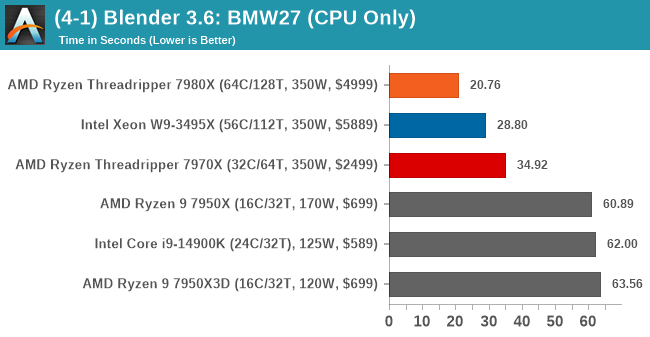
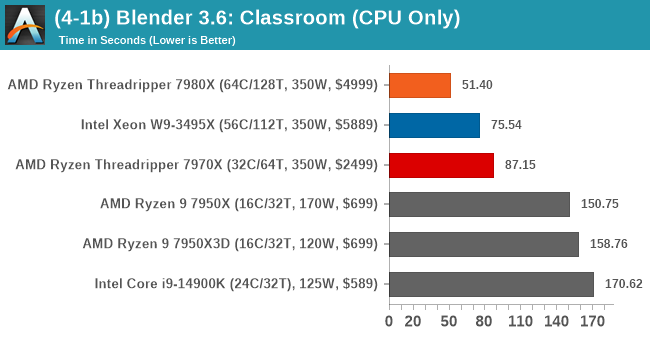
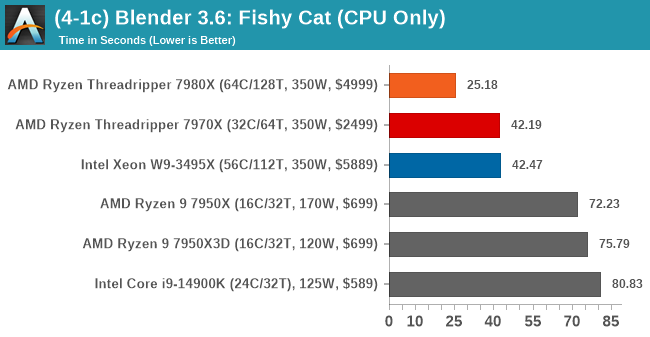
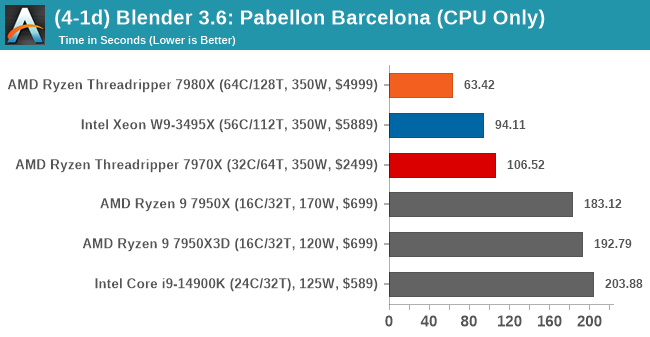
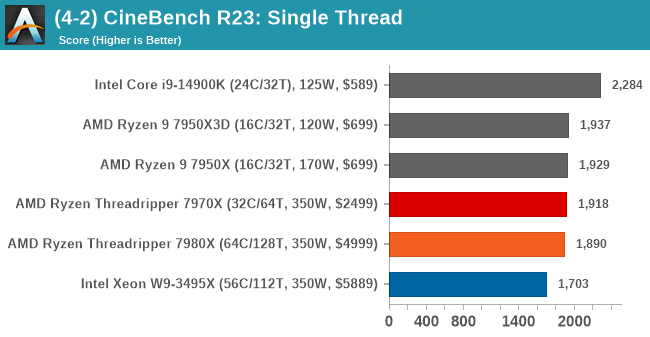
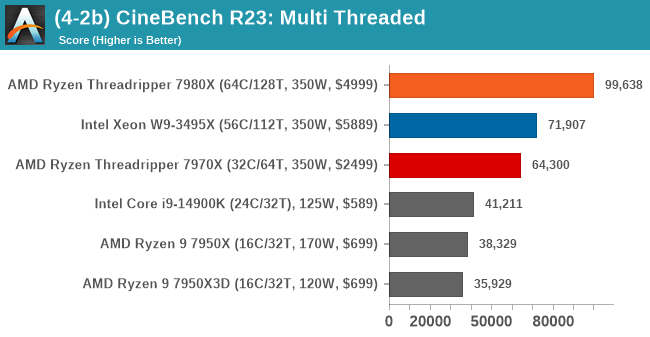
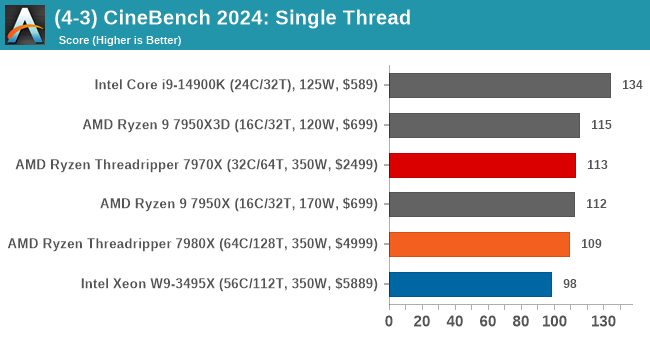
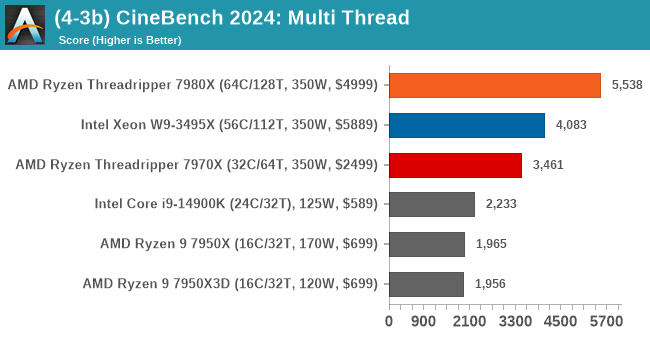
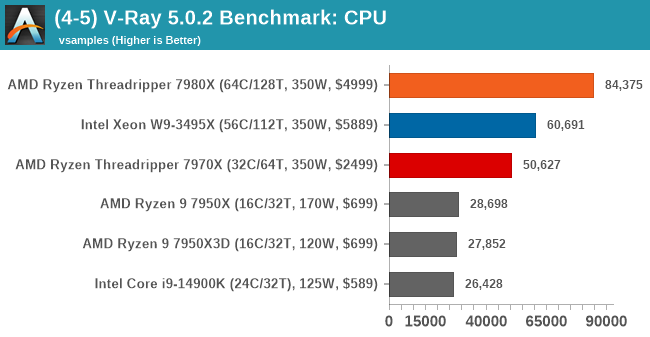
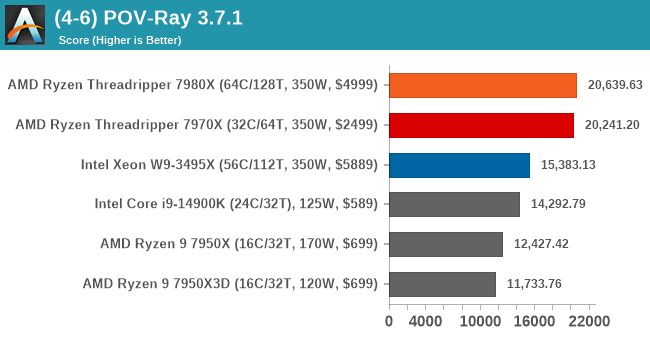
Now we come to where the AMD Ryzen Threadripper 7000 (and Xeon W9-3495X) excel, rendering. In all of the multi-threaded rendering benchmarks, the Threadripper 7980X makes the desktop chips look fairly insignificant in comparison. Interestingly, the Threadripper 7970X ($2499) with 32C/64T performs relatively close to the Xeon W9-3495X ($5889) with 56C/112T. This shows AMD's Zen 4 core not only performs exceptionally well in rendering from a price to performance point of view compared to Intel, but the Threadripper 7980X ($4999) with 64 Zen 4 cores is very well suited to users looking to render videos and other rendering based workloads.
TR 7000 vs. Intel: Science And Simulation
Our Science section covers all the tests that typically resemble more scientific-based workloads and instruction sets. Simulation and Science have a lot of overlap in the benchmarking world. The benchmarks that fall under Science have a distinct use for the data they output – in our Simulation section, these act more like synthetics but, at some level, are still trying to simulate a given environment.
In the encrypt/decrypt scenario, how data is transferred and by what mechanism is pertinent to on-the-fly encryption of sensitive data - a process by which more modern devices are leaning to for software security.
Adding to our 2024 CPU suite, we've included the Montage Astronomical Image Mosaic Engine (MAIM) benchmark and OpenFOAM 1.2 and retained our gaming simulation benchmarks, including our Dwarf Fortress and Factorio benchmarks.
We are using DDR5-5200 RDIMM memory on the Ryzen Threadripper 7980X and 7970X as per JEDEC specifications. For Intel's Xeon W9-3495X, we are using DDR5-4800 RDIMM memory as per Intel's JEDEC specifications. It should be noted that both platforms are run with their full allocation of memory channels, eg, TR7000 in 4-channel and Sapphire Rapids in 8-channel.
Below are the settings we have used for each platform:
- DDR5-5200 RDIMM - AMD Threadripper 7000
- DDR5-4800 RDIMM - Intel Xeon Sapphire Rapids WS
- DDR5-5600B CL46 - Intel 14th Gen
- DDR5-5200 CL44 - Ryzen 7000
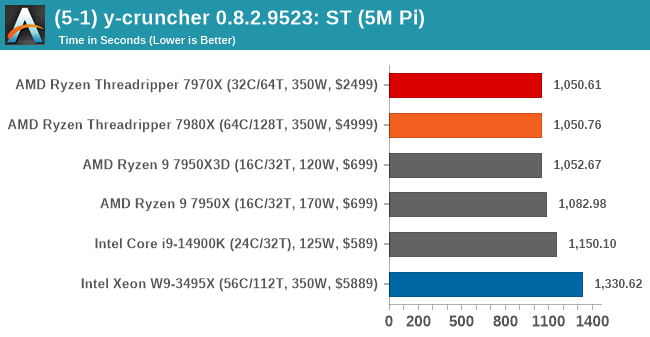
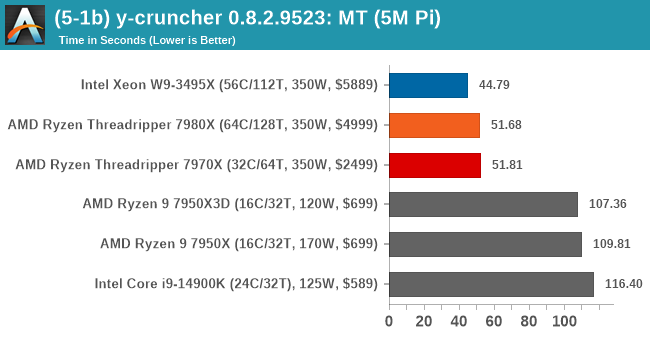

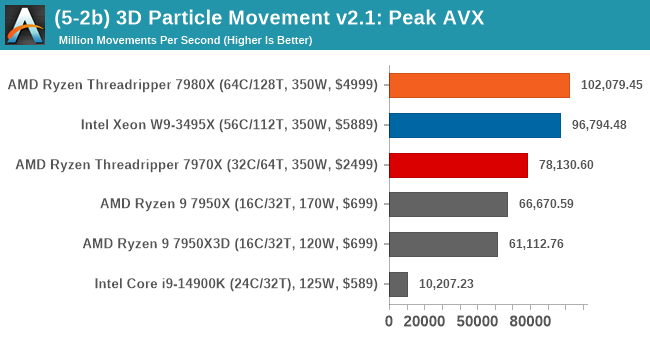
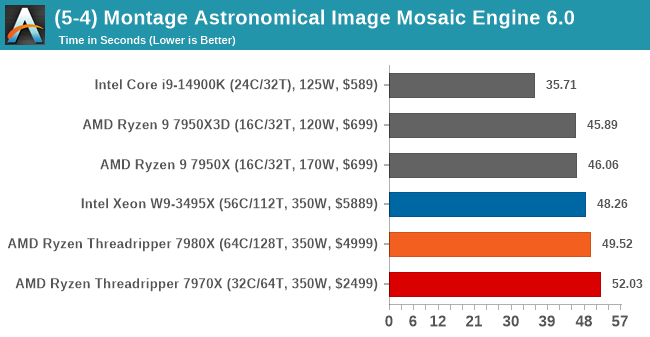
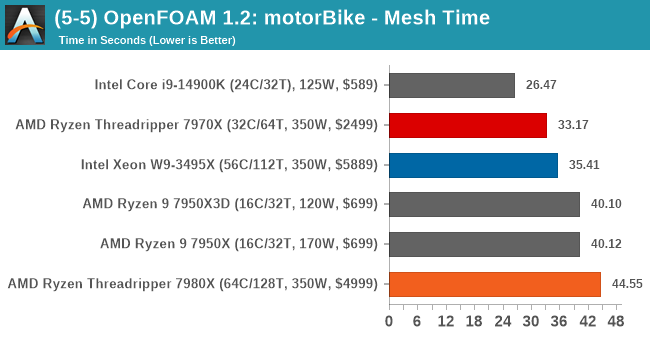
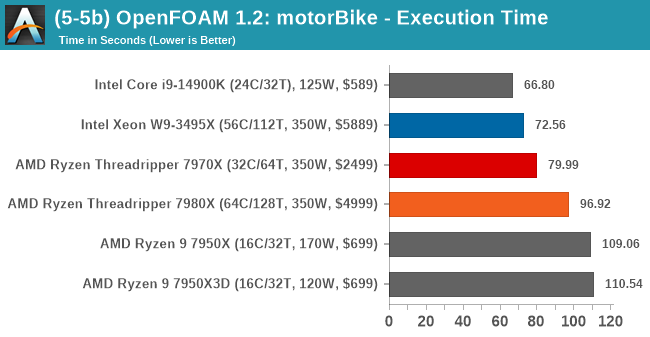
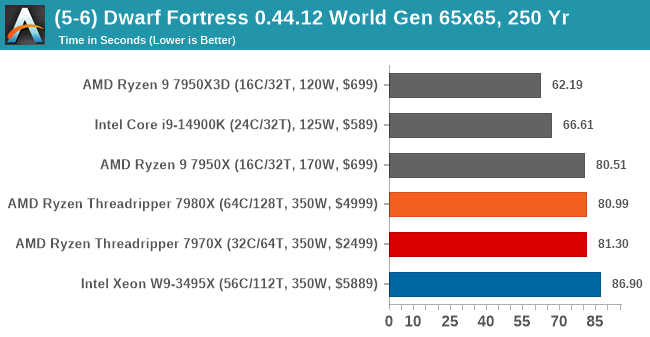
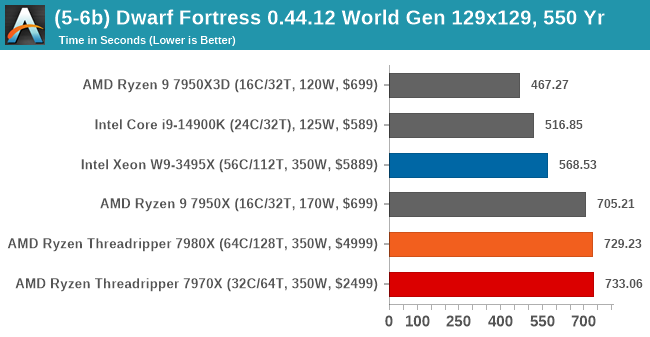

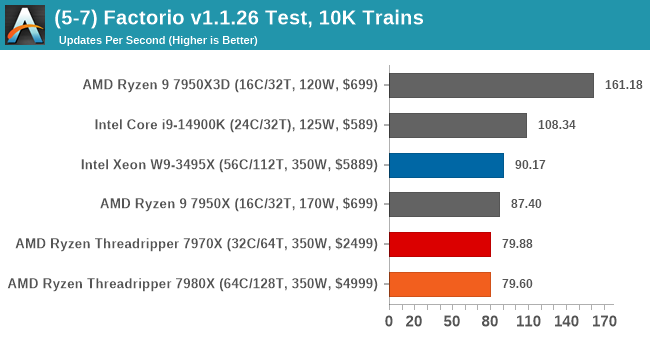
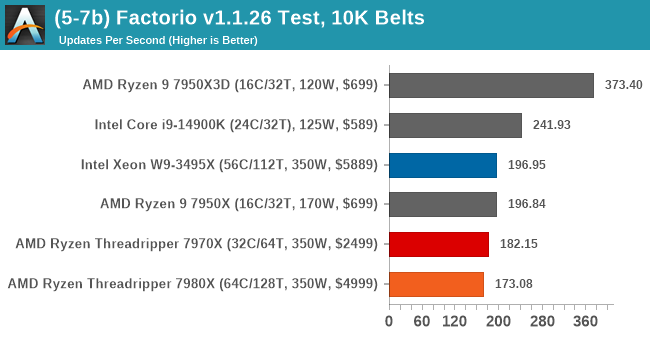
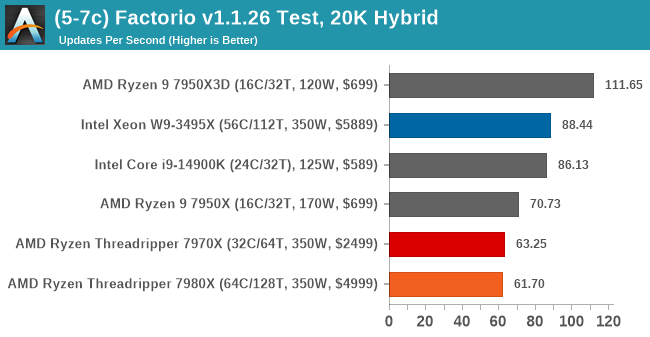
Starting with performance in y-Cruncher 0.8.2.9523, the Ryzen Threadripper 7980X and 7970X sit marginally above the desktop chips in the single-threaded test. We should note that the core clock speeds are slower on the Intel Xeon W9-3495X, which contributes to why it's at the bottom of the list, but in the multi-threaded test, Intel's workstation chip wins out from the pair of Threadripper 7000 series chips.
In Dr Ian Cuttress's 3DPM V2.1 benchmark, the Threadripper 7980X is on top by a massive margin in the non-AVX test, with a much closer result to the Xeon W9-3495X in the peak AVX test. The Core i9-14900K performs badly in this test because it is the only chip in the graphs that doesn't officially support AVX-512 or AVX instruction sets.
In our more broad simulation tests, such as in Dwarf Fortress and Factorio, the Ryzen 9 7950X3D with its 96 MB of 3D V-Cache on one of the CCDs reigns ultimately supreme. Despite having 256 MB of L3 cache available to the Threadripper 7980X, it is split across 8 x CCDs, meaning each CCD has 32 MB of L3 cache.
TR 7000 vs. Intel: AI and Inferencing
As technology progresses at a breakneck pace, so too do the demands of modern applications and workloads. With artificial intelligence (AI) and machine learning (ML) becoming increasingly intertwined with our daily computational tasks, it's paramount that our reviews evolve in tandem. Recognizing this, we have AI and inferencing benchmarks in our CPU test suite for 2024.
Traditionally, CPU benchmarks have focused on various tasks, from arithmetic calculations to multimedia processing. However, with AI algorithms now driving features within some applications, from voice recognition to real-time data analysis, it's crucial to understand how modern processors handle these specific workloads. This is where our newly incorporated benchmarks come into play.
As chip makers such as AMD with Ryzen AI and Intel with their Meteor Lake mobile platform feature AI-driven hardware within the silicon, it seems in 2024, and we're going to see many applications using AI-based technologies coming to market.
We are using DDR5-5200 RDIMM memory on the Ryzen Threadripper 7980X and 7970X as per JEDEC specifications. For Intel's Xeon W9-3495X, we are using DDR5-4800 RDIMM memory as per Intel's JEDEC specifications. It should be noted that both platforms are run with their full allocation of memory channels, eg, TR7000 in 4-channel and Sapphire Rapids in 8-channel.
Below are the settings we have used for each platform:
- DDR5-5200 RDIMM - AMD Threadripper 7000
- DDR5-4800 RDIMM - Intel Xeon Sapphire Rapids WS
- DDR5-5600B CL46 - Intel 14th Gen
- DDR5-5200 CL44 - Ryzen 7000
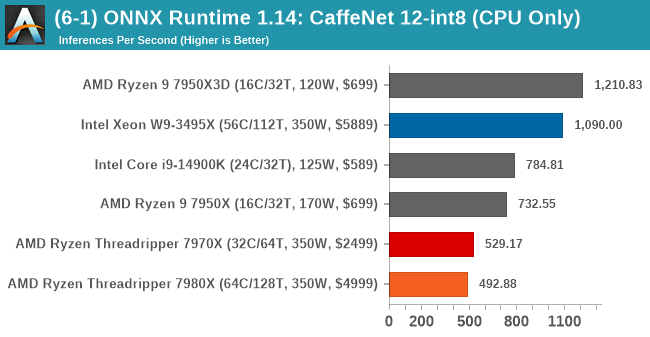

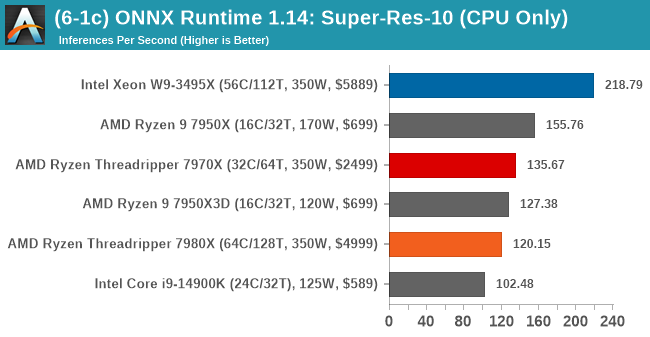
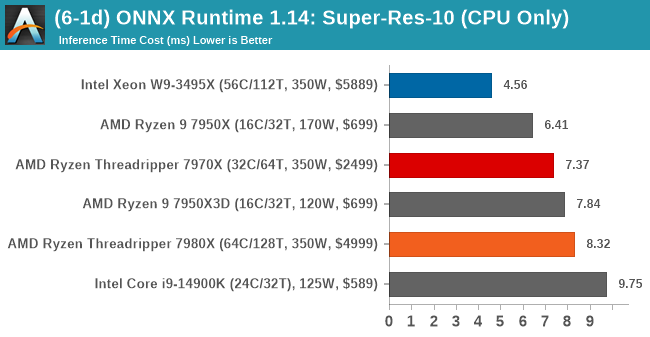
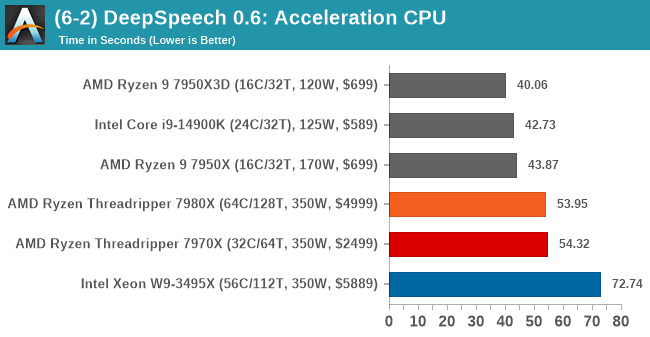
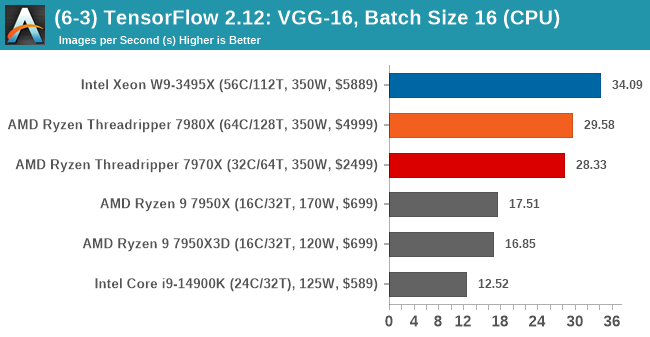
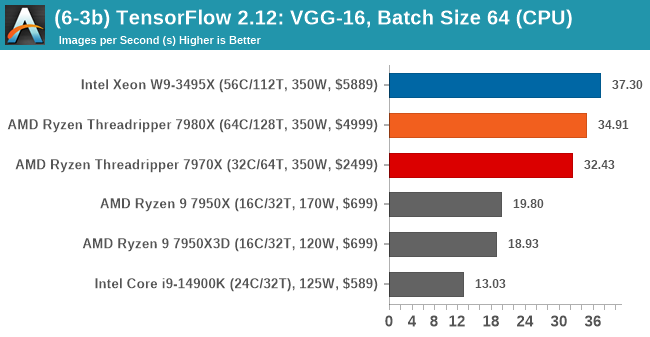

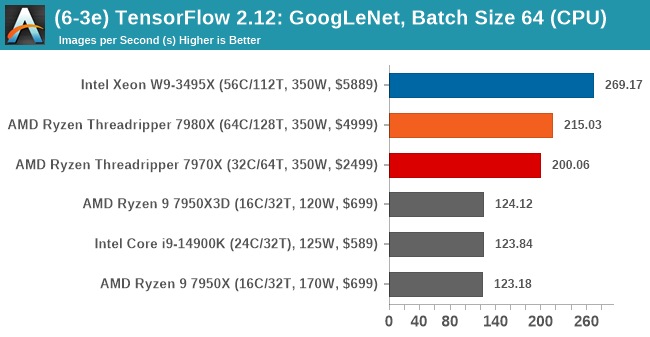

Although there are various AI and machine learning algorithms and models, different architectures and characteristics play a different part within the ecosystem. Looking at performance in the ONNX Runtime benchmark using CaffeNet 12-int8, we see much better performance from faster cores, and in the case of the Ryzen 9 7950X3D, the additional 3D V-Cache plays a massive part in performance here. Using the Super-Res-10 model, the Intel Xeon W9-3495X is much more optimized here than the rest of the chips, with the Threadripper 7000 pairing performing closely with the desktop CPUs tested.
In the DeepSpeech benchmark, the desktop CPUs reign supreme, whereas in TensorFlow with VGG, the Xeon W9-3495X has a good advantage over the Threadripper 7000 chips. As the batch size increased, the Threadripper 7980X and 7970X performed better than the desktop chips, such as with a 64 and larger 256 batch size.
Since AMD's Ryzen Threadripper 3000 series rode off into the sunset in 2021, the high-end desktop (HEDT) market has essentially been dead. With desktop processors coming out with higher and higher core counts almost every generation, the very high core counts of HEDT haven't brought the same impact as they once did. Although we still haven't seen 32C/64T and 64C/128T chips on desktops – and who knows if we ever will – the performance that the flagship desktop processors such as Intel's Core i9-14900K and AMD's Ryzen 9 7950 and 7950X3D processors bring to the table is already fantastic. But we still want more, and this is where HEDT comes in.
Given the rapidly progressive nature of desktop platforms over the last 4 or 5 years, is there much benefit to opting for HEDT in 2023? AMD seems to think so, and to that end has brought three HEDT chips to the market in the form of the Ryzen Threadripper 7000 series, ranging from 64C/128T down to 24C/48T, with a 32C/64T in between these for good measure.
| AMD Ryzen 7000 (Zen 4) CPU Comparison | ||||
| AnandTech | Ryzen | Threadripper | Threadripper Pro | EPYC (Genoa) |
| Cores | 6-16 | 24-64 | 12-96 | 16-96 |
| Architecture | Zen 4 | Zen 4 | Zen 4 | Zen 4 |
| 1P Flagship | R9 7950X | TR 7980X | TR Pro 7995WX | EPYC 9654P |
| MSRP | $550 | $4999 | TBD | $10,625 |
| TDP | 170 W | 350 W | 350 W | 360 W |
| Base Freq | 4500 MHz | 2500 MHz | 2500 MHz | 2400 MHz |
| Turbo Freq | 5700 MHz | 5100 MHz | 5100 MHz | 3700 MHz |
| Socket | AM5 | sTR5 | sTR5 | SP5 |
| L3 Cache | 64 MB | 256 MB | 384 MB | 384 MB |
| DRAM Channels | 2 x DDR5-5200 | 4 x DDR5-5200 | 8 x DDR5-5200 | 12 x DDR5-4800 |
| DRAM Capacity | 192 GB (UDIMM) |
1TB, ECC (RDIMM) |
2 TB, ECC (RDIMM) |
6 TB, ECC (RDIMM) |
| PCIe | 5.0 x24 + chipset (x4) |
5.0 x48 + 4.0 x32 + chipset (x4) | 5.0 x128 + 4.0 x8 + chipset (x4) | 5.0 x128 |
| Pro Features | No | No | Yes | Yes |
Looking specifically at the options available with AMD's Zen 4 cores across the entirety of the processor landscape, the above table is a good indicator of how scalable Zen 4 is. The AMD Ryzen 9 7950X, along with the Ryzen 9 7950X3D, represents the best Zen 4 chips on the desktop platform, with 16C/32T, which isn't too far away from the Ryzen Threadripper 7960X with 24C/48T. Of course, the Ryzen 9 7950X is $550, and the Ryzen Threadripper 7960X is $1499. This means that without all of the specific platform features, such as going from dual to quad-channel memory and higher density RDIMM memory, the 7950X is around £34.37 per Zen 4 core, while the 7960X is much more expensive at $62.45 per core. While price per core isn't a linear benchmark of performance or anything like that, it does show that AMD's AM5 platform is much more cost-effective per core than AMD's latest HEDT offerings.

Typically, enthusiasts and power users looking for higher core chips typically have bigger wallets, so cost isn't as much of an issue. The Ryzen Threadripper 7000 is essentially a bridge between AMD's desktop and workstation portfolios, and further beyond this is AMD EPYC, which is designed for server and cloud environments. From our testing, there's a clear benefit for users looking to upgrade from the existing HEDT platforms, such as Ryzen Threadripper 3000, to the new 7000 series. This goes not just for single-threaded performance, but the Ryzen Threadripper 7000 series offers much more potent multi-threaded performance, too. If AMD had opted to launch Threadripper with Zen 3, the gap would have been smaller, but still, Zen 4 is a better and more efficient core architecture, which we've seen in our reviews, including that of the Ryzen 9 7950X3D.
AMD Threadripper 7000 vs. Intel Sapphire Rapids WS: Performance Analysis
Looking at the performance comparisons between AMD's Ryzen Threadripper 7000 and Intel's current Sapphire Rapids Xeon W9-3495X (56C/112T), it should be noted that Intel's platform supports 8 channels of memory while Threadripper 7000 and the TRX50 chipset are limited to 4 channels. This means the W9-3495X has more memory bandwidth than AMD's options. While AMD's Threadripper Pro 7000 WX-series is more compatible with platforms, features, and manageability, the W9-3495X is Intel's flagship workstation processor currently on the market. With a price of $5889, it's not a cheap investment. The Ryzen Threadripper 7980X ($4999) is also similarly priced (i.e. expensive), so it's a worthwhile comparison to make.

In the longest Blender 3.6 rendering test (Pabellon Barcelona), we can see that the AMD Ryzen Threadripper 7980X ($4999) was around 32% quicker than the Intel W9-3495X. Even the 32C/64T Ryzen Threadripper 7970X ($2499) was only around 11% slower than Intel's flagship workstation chip, showing that it is no slouch in that department. All three of the chips mentioned above are much quicker in rendering than any of the current desktop flagships on the market.

Looking at performance in the latest CineBench 2024 benchmark, we can see similar levels of multi-threaded performance to Blender, where the Ryzen Threadripper 7980X is around 35% ahead of Intel's W9-3495X despite having just 14% more cores. Even the 7970X (32C/64T) shows it's good at rendering, as it's around 18% slower than the W9-3495X, with 42% fewer cores.
It's clear that in multi-threaded rendering performance, the AMD Ryzen Threadripper 7980X ($4999), despite having eight more cores than the W9-3495X ($5889), half the memory channels (4 vs. 8) and being ultimately cheaper, it is the better option. Even the Ryzen Threadripper 7970X ($2499) isn't too far off in rendering performance compared to the W9-3475X and, at less than half the price, really punches above its weight compared to what Intel is offering in the HEDT/workstation space. Threadripper 7000 also decimates the desktop chips in multi-threaded performance, especially where all of the cores can be optimally utilized, such as in rendering.
AMD Threadripper 7000 vs. Desktop Flagships: Performance Analysis
While it's clear in multi-threaded workloads such as rendering, the Ryzen Threadripper 7980X and 7970X are more potent with higher core counts, there are certain situations where the current desktop flagship processors still represent a better buy.

Looking at the performance in Dwarf Fortress, we see that the Threadripper 7980X and 7970X don't do as well in this situation as the desktop chips do. Balancing lower core counts with higher core clock speeds, such as the 6.0 GHz Intel Core i9-14900K ($589), provides better performance when more cores aren't as advantageous as a higher core frequency. Where having higher core clock frequencies is important, we must note that the Threadripper 7980X has a turbo core clock speed of up to 5.1 GHz, while the Core i9-14900K can reach up to 6.0 GHz, which, with its 24-cores, still performs exceptionally well. And even in a pure AMD match-up, we're looking at a 5.8GHz 7950X versus the 5.1GHz Threadripper processors.
Meanwhile we have the uniquely awesome AMD Ryzen 9 7950X3D, which has 96 MB of L3 3D V-Cache on one CCD. The 7950X3d still provides better benefits in simulations, and where L3 cache can be utilized, it gives AMD's 3D V-Cache enabled chips a solid advantage in these situations. Even though the Threadripper 7980X has 256 MB of L3 cache in total, this is split into 8x CCDs, each with eight cores and 32 MB per CCD, so Threadripper runs into the latency costs of going off-die (and through the I/O Die) to access additional L3 cache.

Another situation where higher core frequencies are key is in single-threaded workloads, and as we can see in CineBench 2024 ST, the Core i9-14900K with turbo clock speeds of up to 6.0 GHz reigns supreme here. Whereas bringing up the rear is the Intel Xeon W9-3495, which has a turbo clock speed of 4.8 GHz. Ultimately there's nothing here that is a surprise, but it confirms the basic assumption that these many-core workstation ships aren't going to be able to match the single-threaded performance of a flagship desktop chip.
Final Thoughts: Is HEDT Back? AMD Thinks So
Both the Ryzen Threadripper 7980X and 7970X are designed for situations where high core and thread counts translate directly into more performance. For users involved in industries and use workloads such as video editing, 3D rendering, and large-scale data processing, the 7980X offers a distinct advantage with its 64 cores/128 threads over conventional desktop processors. Faster rendering times in complex projects mean users can render projects quicker, thus saving valuable time. Even the 7970X, with its 32 cores, is well suited for workloads such as content creation and rendering tasks.
AMD's Ryzen Threadripper 7000 series offers a cut-down and cheaper alternative to the Ryzen Threadripper Pro 7000 WX-series, which is also suitable for these tasks but comes with AMD Pro/manageability features designed for professional environments. Although AMD hasn't unveiled pricing on the Threadripper Pro 7000 WX-series processors, these will undoubtedly cost much more.
Considering the high investment for the Ryzen Threadripper 7980X and 7970X, potential buyers must weigh their performance needs against the cost. While the higher core and thread counts of the 7980X ($4999) command a premium price, they offer better multitasking capabilities than current desktop processors, making them a worthy investment for professionals whose time savings translate to significant financial benefits. The 7970X ($2499), positioned at a lower price point, provides plenty of power for most tasks and workloads, giving users a more cost-effective solution for those needing more performance without needing the top-tier performance of the 7980X. This pricing structure isn't linear to AMD's current Ryzen 7000 desktop pricing, and for things such as gaming, these are much better suited with faster core frequencies.
As the landscape continues to evolve, AMD's position with the Threadripper 7000 series makes a statement in the HEDT market, but is HEDT viable today? Analyzing the cost a little further, AMD TRX50 motherboards are certainly more expensive than AMD's desktop AM5 motherboards, and the cost per Zen 4 core on Threadripper 7000 is much higher than Ryzen 7000. The crux of the matter comes down to workflow, tasks, and requirements; Threadripper 7000 excels in tasks such as rendering, where having more cores and threads directly translates into more performance. For most users, though, Ryzen 7000 or even Intel's 14th Generation Core family will satisfy most users' demands.

